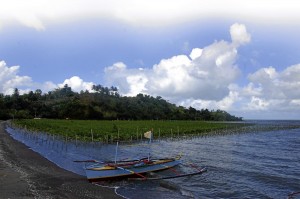
NATURAL BARRIER The new mangrove plantation, started in 2009 in Cagsao, Calabanga, Camarines Sur, is continuously expanding because visitors pitch in to plant mangrove seedlings. JUAN ESCANDOR JR.
CALABANGA, Camarines Sur—With over five hectares of green canopy rising and creeping above the shallow tidal flat, a mangrove plantation in Calabanga town in Camarines Sur has been attracting volunteers since 2009.
The mangrove project in Cagsao, 39 kilometers northeast of Naga City, is part of the community’s disaster risk reduction and mitigation plan, according to its barangay chair, Pascual Sta. Ana.
Cagsao, a coastal village highly vulnerable to storm surge sits on the side of a steep hill before dropping to the narrow shoreline. It has over 1,600 people, mostly fishermen. In all, 730 families are clustered in seven zones, 21 of them living in front of the mangrove plantation.
Sta. Ana said the project is one of the small-scale measures undertaken by the community so it could have a natural buffer against storm surges.
Smart Communications, through the Corporate Network for Disaster Response (CNDR), provided the propagules or mangrove seedlings and other materials while volunteers from the community took care of planting them, he said. The CNDR, composed of 15 corporations, aims to institutionalize disaster management efforts of the business community.
Volunteers
Sta. Ana said the villagers had provided food to the volunteers who plant the seedlings. Nurturing of the growing plants is the work of the barangay and municipal governments.
Since last year, students, teachers, health professionals and a number of foreigners from development organizations have come in droves to visit Cagsao to help plant some 50,000 seedlings.
Nova Clotario Concepcion, head of Smart’s Community Partnership-Public Affairs Group, observed how life had gradually returned to the shores since the first seedlings were planted in 2009.
“The community can now even embark on an ecotourism project to showcase the successful practice of mangrove reforestation,” she said.
LGU role
Credit must go to the villagers and their officials, and the municipal government for the success of the project, Concepcion said.
“The community has a very high awareness of disaster risk reduction and mitigation concepts,” said Concepcion, who reported a high 90-percent survival rate of the propagules.
She remembered how a storm surge once leveled seven hectares of sandbar and rerouted the passageway of the Inirihan River straight into San Miguel Bay. The tidal flat became ideal for the mangrove reforestation project, said Concepcion.
Sta. Ana noted how the thriving mangroves also dramatically increased the stocks of crablets in Cagsao. This, he said, prompted a ban on the gathering of stocks inside the plantation area.
To ward off gatherers of crablets, he said they assigned nine caretakers to patrol the fenced mangrove plantation and drive away gatherers from the neighboring village. The caretakers, who get paid P600 honorarium by the municipality, also clean up trash, mostly plastic materials, entwined around the young mangrove trees, said Mayor Evelyn Yu.
NGOs
A fisherman said that during the crab season, he was earning P300 or double of what he used to earn before. Traders buy the crabs at P40 to P60 per kilo, he said.
Another fisherman said the thriving mangroves enhanced production of krill, a raw material used to make fish paste, which, in turn, gave him extra income, especially when he could not go out to the sea to fish during bad weather.
Sta. Ana said in 2000, Care Philippines gave the villagers a series of training on disaster awareness and response measures. Later, a program called Advancing Safe Community and Environment Against Disaster (Ascend) improved the community’s capacity to protect the mangroves.
Ascend hastened the construction of a gabion structure at the edge of the village center to prevent storm surges and to protect more than a hundred houses facing San Miguel Bay.
Humanitarian aid
Sta. Ana said that upon Ascend’s phaseout last year, the CNDR-led Project Strengthening Assets and Capacities of Communities and Local Government for Resilience to Disaster (Accord) took over.
Funded by the European Commission’s humanitarian aid, Accord aims to strengthen the capability of Cagsao to manage the reforestation project.
To date, assistance from various organizations continue to help the community respond to disasters. The efforts have resulted in 108 villagers grouping into committees and training to handle various tasks should a disaster strike Cagsao.
Four pieces of batingting, an empty oxygen tank used as a warning device whenever an environmental threat occurs, are scattered around the village.